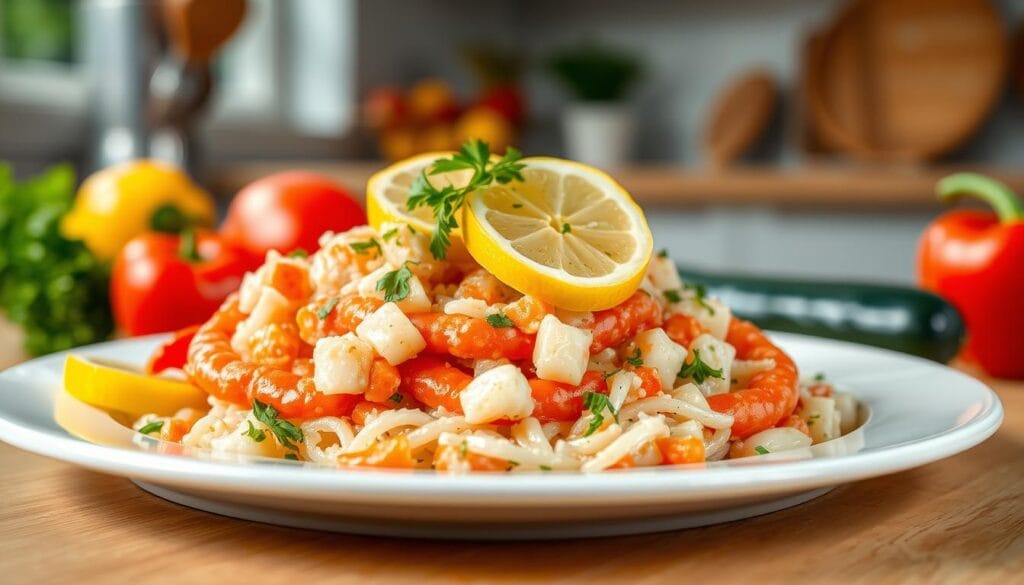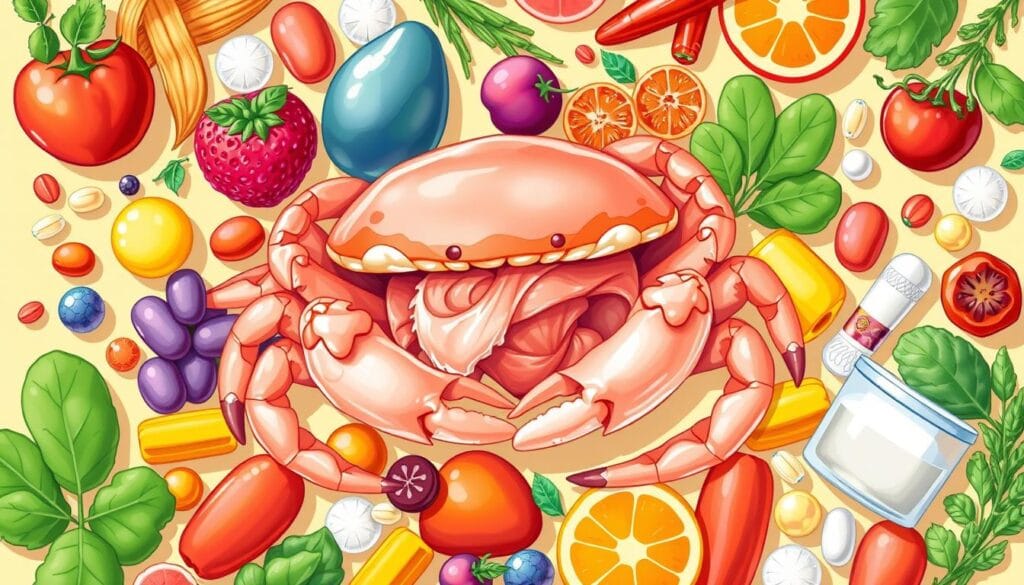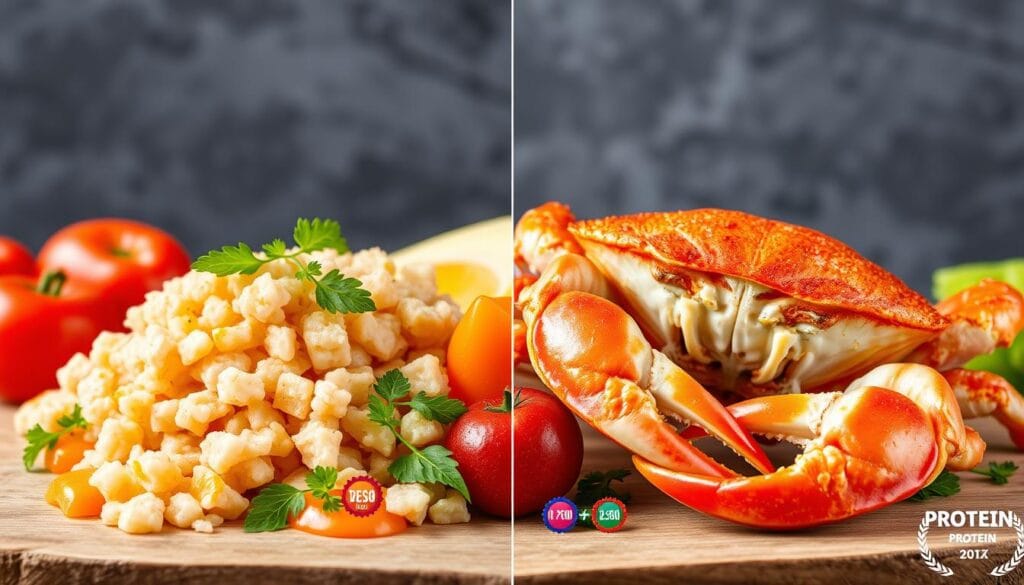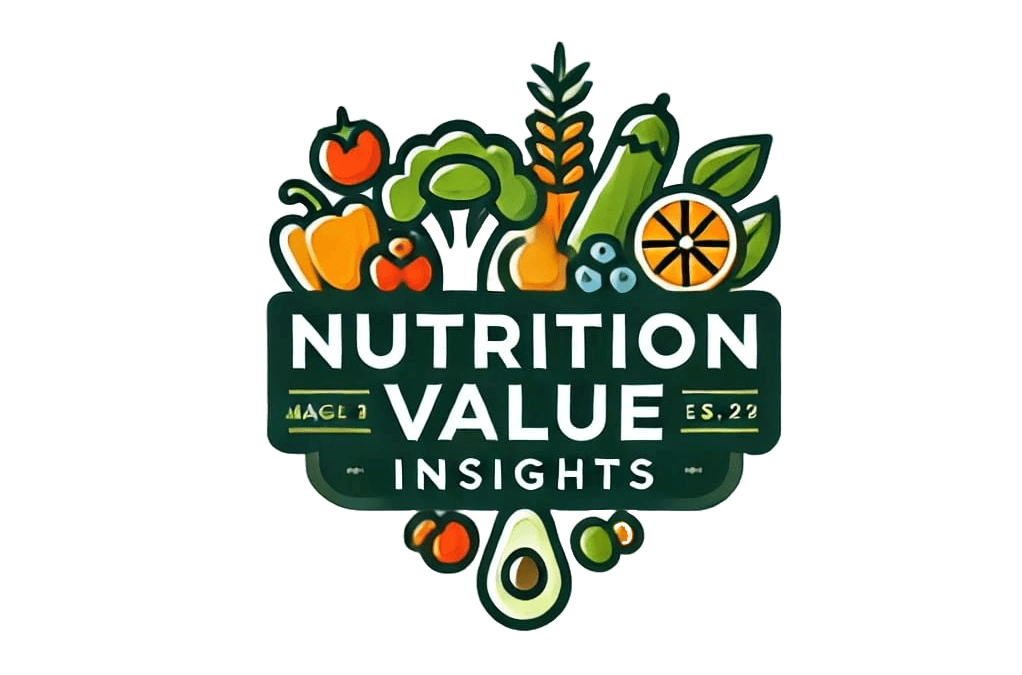Imitation Crab Meat Nutrition Info: Calories, Protein, and Health Facts
Imitation crab meat, also known as surimi, is a seafood alternative that’s very popular in the U.S. It tastes and feels like real crab, but it’s important to know its nutritional facts. We’ll explore the calories, protein, and health aspects of imitation crab meat in this article.

Table of Contents
Understanding Imitation Crab Meat: What It Really Is
Imitation crab meat, also known as surimi, is a common ingredient in seafood dishes. But, it’s not made from real crab. It’s made by processing fish, usually pollock, to look and taste like crab.
Components of Surimi Base
The main part of imitation crab meat is surimi, a fish paste. To make it look like crab, egg white, starch, and vegetable oil are added. Coloring agents give it the crab’s reddish-pink color.
Manufacturing Process
To make imitation crab, fish is first deboned and washed. Then, it’s turned into a fine paste. This paste is mixed with binding agents and flavorings, then shaped like crab. Finally, it’s packaged for use in many dishes.
Common Uses and Applications
Imitation crab is used in many seafood dishes. It’s found in salads, sushi, and as a cheaper crab substitute in crab cakes and dips. Its flexibility and low cost make it popular in cooking.
Imitation crab may not be as nutritious as real crab. But, it’s a good choice for those wanting crab flavor and texture without the high cost. Knowing how it’s made helps people make better food choices.
Imitation Crab Meat Nutrition Info: Complete Breakdown
Understanding the nutritional breakdown of imitation crab meat is key. A 3 oz (85g) serving has 81 calories. It also has 0.39g of total fat and 0.18g of saturated fat. The carbs are 12.8g, with 5.3g of sugars and 0.43g of fiber.
The protein in it is 6.5g, which is 13% of what we need daily. This makes it a good choice for those looking for a healthier seafood option. But, remember, the imitation crab meat nutrition info can change based on the brand and how it’s made.
| Nutrient | Amount per 3 oz (85g) Serving | % Daily Value |
|---|---|---|
| Calories | 81 | – |
| Total Fat | 0.39g | 1% |
| Saturated Fat | 0.18g | 1% |
| Carbohydrates | 12.8g | 5% |
| Sugars | 5.3g | – |
| Fiber | 0.43g | 2% |
| Protein | 6.5g | 13% |
| Cholesterol | 17mg | 6% |
The carbs in imitation crab meat and the fat content in imitation crab are low. This makes it good for those on a balanced diet. But, some products might have additives or fillers that change the nutrition. Always eat in moderation and vary your diet for a healthy lifestyle.
Caloric Content and Macronutrient Distribution
Imitation crab meat’s nutritional profile is key. A 3-ounce (85-gram) serving has 81 calories. This is lower than many seafood options, making it great for calorie control.
The macronutrient breakdown is interesting too. It has 32% of calories from protein, which is good. But, it gets 64% of calories from carbohydrates, more than real crab meat.
Also, imitation crab meat has only 4% of calories from fat. This is good for those watching their dietary fat intake.
Daily Value Percentages
A 3-ounce serving of imitation crab meat gives 13% of the daily protein you need. But, it only gives 5% of the daily carbohydrate and 1% of the daily fat you need.
These numbers show imitation crab meat is low in calories and high in carbs compared to real crab. Knowing this helps you decide if it’s right for your diet.
Protein Content and Amino Acid Profile
Imitation crab meat has about 6 grams of protein per 3-ounce serving. This is 13% of what we need daily. It has less protein than real crab but still has essential amino acids for health.
Some key amino acids in imitation crab meat are:
- Histidine (133mg)
- Isoleucine (196mg)
- Leucine (516mg)
- Lysine (601mg)
- Methionine (222mg)
- Phenylalanine (221mg)
- Threonine (242mg)
- Tryptophan (64mg)
- Valine (243mg)
These amino acids are vital for muscle growth, repair, and enzymes. Even with less protein, imitation crab is a good source of these nutrients in a balanced diet.
“Imitation crab meat may not have the same protein punch as real crab, but it still offers a variety of important amino acids that can benefit your health.”
Carbohydrates and Sugar Content Analysis
Imitation crab meat’s carbs and sugars are key to consider. A 3-ounce serving has about 12.8 grams of carbs, which is 5% of what we need daily. But, a big part of these carbs are added sugars, with up to 5.3 grams per serving.
Imitation crab has very little fiber, only 0.43 grams per 3-ounce serving. This is just 2% of what we should eat daily. For those on a low-carb or keto diet, imitation crab might not be the best choice. Its carbs can quickly add up and mess with ketosis.
Total Carbohydrates
A 3-ounce serving of imitation crab has 12.8 grams of carbs, which is 5% of our daily needs. The carbs mainly come from the surimi base, made from fish and starches.
Added Sugars and Natural Sugars
Imitation crab also has added sugars, up to 4 grams per serving. The natural sugars come from the fish and other ingredients in the surimi base. The American Heart Association suggests we get no more than 6% of our calories from added sugars. So, the sugar in imitation crab is something to think about, especially for those watching their sugar intake.
Fiber Content
Imitation crab has very little fiber, just 0.43 grams per 3-ounce serving. This is only 2% of our daily fiber needs. Not enough fiber is a concern for a balanced diet, as it’s important for digestion and health.
In summary, the carbs and sugars in imitation crab are something to think about, especially for those on a low-carb or keto diet. Its high carbs and added sugars, along with low fiber, make it less ideal for certain diets.
Vitamin and Mineral Composition
Imitation crab meat is not as packed with nutrients as real crab. Yet, it still has important vitamins and minerals. For example, it has vitamin B12, giving you 24% of what you need daily in just 100 grams. It also has 8% of vitamin B6 and 6% of riboflavin (vitamin B2).
Imitation crab is a good source of selenium, with 41% of your daily value in 100 grams. It also has 23% of phosphorus and sodium. But, it lacks minerals like copper, zinc, and omega-3 fatty acids found in real crab.
| Nutrient | Imitation Crab (per 100g) | Real Crab (per 100g) |
|---|---|---|
| Calories | 95 kcal | 98 kcal |
| Vitamin B12 | 24% DV | 79% DV |
| Vitamin B6 | 8% DV | 24% DV |
| Riboflavin (B2) | 6% DV | 16% DV |
| Selenium | 41% DV | 69% DV |
| Phosphorus | 23% DV | 27% DV |
| Sodium | 23% DV | 18% DV |
Imitation crab may not have as many nutrients as real crab. But, it’s still good for a balanced diet, especially if you’re looking for something affordable. Just remember, it won’t give you the same nutritional benefits as real crab.

Imitation crab is a budget-friendly seafood option. It offers some health benefits, like vitamins in imitation crab meat and imitation crab health benefits. It’s key to eat it as part of a varied diet to get all the nutrients your body needs.
Sodium Levels and Other Minerals
Imitation crab meat has a lot of sodium. A 3-ounce serving has 449.7mg of sodium, which is 19% of what we should eat daily. This is a lot of salt, especially for people with high blood pressure or other health issues.
But, imitation crab meat is not just about sodium. It also has important minerals like phosphorus, selenium, and magnesium. These minerals are good for our health. It also has small amounts of calcium, iron, potassium, zinc, and copper.
| Mineral | Amount per 3 oz Serving | Percentage of Daily Value |
|---|---|---|
| Sodium | 449.7mg | 19% |
| Phosphorus | 239.7mg | 19% |
| Selenium | 19mcg | 34% |
| Magnesium | 36.6mg | 9% |
| Calcium | 22.3mg | 2% |
| Iron | 0.4mg | 2% |
| Potassium | 182.3mg | 4% |
| Zinc | 0.7mg | 6% |
| Copper | 0.1mg | 6% |
Even though imitation crab meat has a lot of sodium, it also has many good minerals. It’s important to watch how much sodium we eat. But, the other nutrients in imitation crab meat are good for us.
Real Crab vs. Imitation Crab Nutritional Comparison
Choosing between real and imitation crab can affect your nutrition. Imitation crab is cheaper and easier to find, but real crab is healthier.
Real crab comes from the sea and is full of vitamins, minerals, and omega-3s. It has more protein and less carbs, great for low-carb diets. Imitation crab, on the other hand, is made from fish and additives, with little real fish.
- Real crab meat is richer in vitamins like B12, folate, and niacin, as well as minerals like selenium and zinc.
- Imitation crab lacks the nutritional profile of real crab, with fewer vitamins, minerals, and healthy fats.
- Imitation crab often contains artificial ingredients like food coloring and added sugars, which can make it less healthy.
Even though imitation crab is cheaper and easier to find, it’s not as nutritious. Real crab is better for your health because it’s packed with nutrients. Your choice should depend on what you prefer and need for your diet.

“Real crab meat is significantly more nutritionally dense compared to imitation crab.”
Conclusion
Understanding imitation crab meat nutrition info is key. This processed seafood is made from fish paste with extra ingredients. It’s less nutritious than real crab meat.
It’s cheaper but has more carbs and sodium. It also has less protein and good nutrients than real crab.
Thinking about imitation crab is healthy for you? You need to look at both its nutrition and cost. Real crab meat is packed with more vitamins, minerals, and omega-3s.
But, imitation crab is good for those watching their weight. It has fewer calories and fat.
In the end, choosing between imitation and real crab meat depends on you. It’s about what you like, need, and can afford. Knowing the nutritional differences helps you make a choice that fits your health goals.
FAQ
What is the nutritional profile of imitation crab meat?
A 3 oz (85g) serving of imitation crab meat has 81 calories. It also has 0.39g fat, 6.5g protein, and 12.8g carbohydrates. This makes up 13% of daily protein and 5% of daily carbs.
What is imitation crab meat made of?
Imitation crab meat is made from surimi, a paste of finely shredded fish, usually pollock. It includes binding agents like egg white, starch, and vegetable oil. It also has coloring to look like crab meat.
How does the nutrition of imitation crab compare to real crab?
Real crab meat has more protein and fewer carbs than imitation crab. This makes it better for low-carb diets. It also has more vitamins and minerals, like vitamin B12, selenium, and zinc.
Is imitation crab meat high in sodium?
Yes, imitation crab meat has a lot of sodium. A 3 oz serving has 449.7mg (19% of the daily value). This is something to watch for if you’re on a low-sodium diet.
Is imitation crab meat a good source of protein?
A 3 oz serving of imitation crab meat has 6.5g of protein, which is 13% of the daily value. It has all the essential amino acids but less protein than real crab.
How does the carbohydrate and sugar content of imitation crab compare to real crab?
Imitation crab meat has more carbs (12.8g per 3 oz serving) and added sugars. Real crab meat has much fewer carbs. This makes imitation crab less good for low-carb or keto diets.
Does imitation crab provide any beneficial vitamins and minerals?
Imitation crab meat has some vitamins and minerals like vitamin B12, vitamin B6, and selenium. But it has less than real crab. It doesn’t have much vitamins A, C, and D.
Is imitation crab meat a healthy choice?
Imitation crab meat is a processed seafood product that’s less nutritious than real crab. It’s cheaper but has more carbs and sodium. It also has less protein and nutrients. Think about nutrition and cost when choosing between imitation and real crab.
DID OUR INFORMATION HELP YOU ?
There are no reviews yet. Be the first one to write one.

